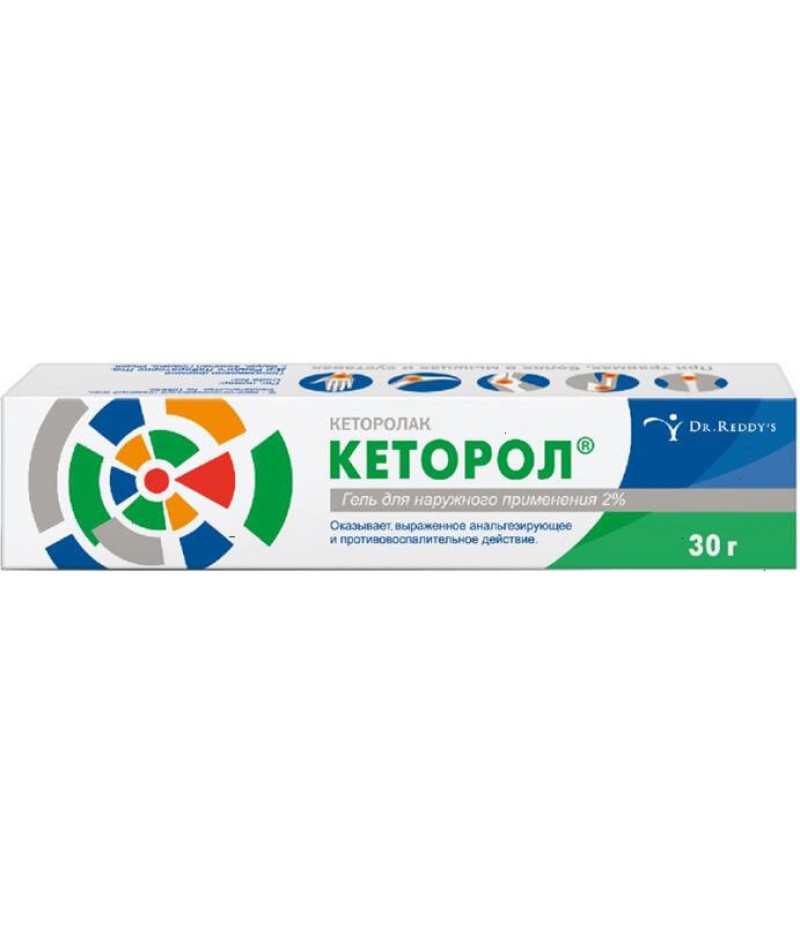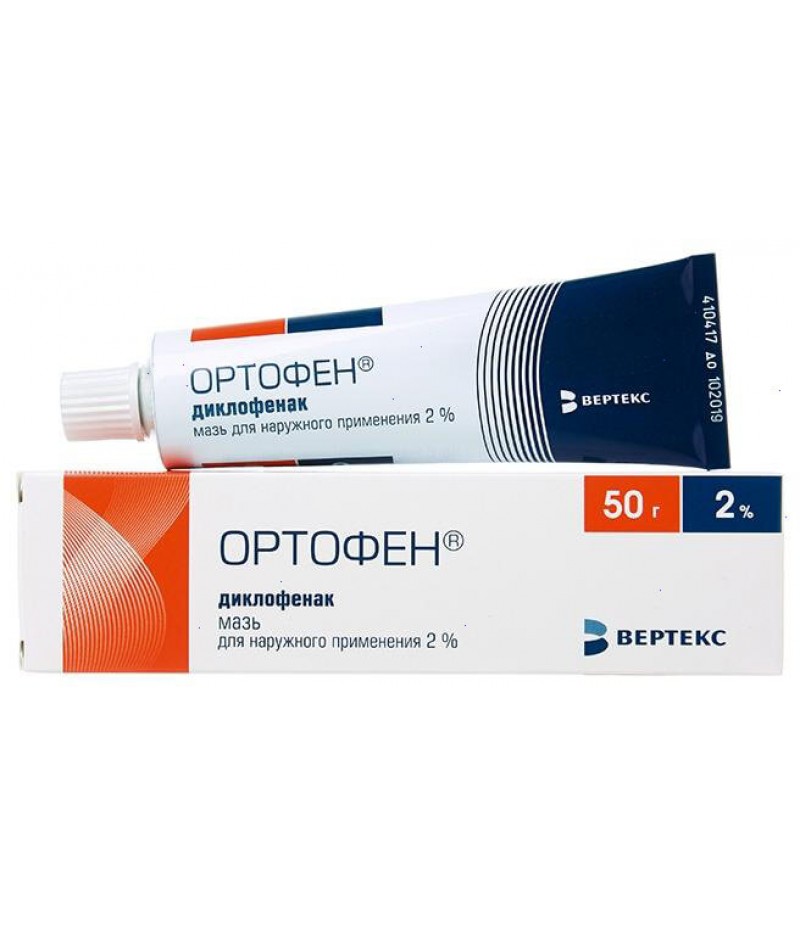Ortofen gel 5% 50gr
- $7.51
- 3 or more $6.90
- Availability:In Stock
Ortofen instruction manualYou can buy Ortofen on this pagePharmacological properties:PharmacodynamicsNSAID, a derivative of phenylacetic acid. Has a pronounced anti-inflammatory, analgesic and moderate antipyretic effect. The mech..
Ortofen instruction manual
You can buy Ortofen on this page
Pharmacological properties:
Pharmacodynamics
NSAID, a derivative of phenylacetic acid. Has a pronounced anti-inflammatory, analgesic and moderate antipyretic effect. The mechanism of action is associated with oppression of the activity of COX, the main enzyme of arachidonic acid metabolism, which is the precursor of prostaglandins, which play a major role in the pathogenesis of inflammation, pain and fever. The analgesic effect is due to two mechanisms: peripheral (indirectly, through suppression of prostaglandin synthesis) and central (by inhibiting the synthesis of prostaglandins in the central and peripheral nervous system).
Inhibits the synthesis of proteoglycan in the cartilage.
When rheumatic diseases reduces pain in joints at rest and during movement, as well as morning stiffness and swelling of the joints, contributes to an increase in the volume of movements. Reduces post-traumatic and post-operative pain, as well as inflammatory edema.
Suppresses the aggregation of platelets. With long-term use has a desensitizing effect.
With topical application in ophthalmology reduces swelling and pain in inflammatory processes of non-infectious etiology.
Pharmacokinetics
After oral administration, it is absorbed from the digestive tract. The intake of food slows the rate of absorption, the degree of absorption does not change. About 50% of the active substance is metabolized by the "first pass" through the liver. With rectal administration, absorption is slower. Time to achieve Cmax in the plasma after ingestion is 2-4 hours, depending on the dosage form used, after rectal administration - 1 hour, IM for 20 minutes. The concentration of the active substance in the plasma is in linear dependence on the amount of the applied dose.
Do not cumulate. Binding to plasma proteins is 99.7% (mainly with albumin). It penetrates into the synovial fluid, Cmax is reached 2-4 hours later than in the plasma.
It is metabolized to a great extent with the formation of several metabolites, among which two are pharmacologically active, but to a lesser extent than diclofenac.
The systemic clearance of the active substance is approximately 263 ml / min. T1 / 2 from plasma is 1-2 hours, from synovial fluid - 3-6 hours. Approximately 60% of the dose is excreted as metabolites by the kidneys, less than 1% is excreted in the urine unchanged, the rest is excreted as metabolites with bile.
Indications for use Ortofen:
Articular syndrome (rheumatoid arthritis, osteoarthritis, ankylosing spondylitis, gout), degenerative and chronic inflammatory diseases of the musculoskeletal system (osteochondrosis, osteoarthritis, periarthropathies), posttraumatic inflammation of soft tissues and musculoskeletal system (sprains, bruises). Pain in the spine, neuralgia, myalgia, arthralgia, pain syndrome and inflammation after operations and trauma, pain syndrome with gout, migraine, algodismenorea, pain syndrome with adnexitis, proctitis, colic (bile and renal), pain syndrome with infectious and inflammatory diseases ENT -organ.
For topical application: inhibition of miosis during surgery for cataracts, prevention of cystoid macular edema associated with removal and implantation of the lens, inflammatory processes of the eye of noninfectious nature, posttraumatic inflammatory process with penetrating and non-penetrating injuries of the eyeball.
Refers to diseases:
Adnexitis Algodysmenorrhea Arthralgia Arthritis ArthrosisBole Syndrome InflammationInfection Cataract Myalgia Migraine Nevralgia Newritis Osteoarthritis Osteoarthrosis Osteochondrosis Periatropathy Podgora Productitis Estimulation Rheumatoid arthritis TrainsWashing Bugs Chistitis
Contraindications:
Erosive-ulcerative lesions of the gastrointestinal tract in the phase of exacerbation, "aspirin triad", disorders of hematopoiesis of unknown etiology, hypersensitivity to diclofenac and components of the dosage form used, or other NSAIDs.
Dosing and Administration for Ortofen:
For oral administration for adults, a single dose is 25-50 mg 2-3 times / day. Frequency depends on the dosage form used, the severity of the disease and is 1-3 times / day, rectally - 1 time / day. To treat acute conditions or arrest the exacerbation of a chronic process, use a 75 mg / m dose.
For children over 6 years and adolescents, the daily dose is 2 mg / kg.
External apply in a dose of 2-4 g (depending on the area of the painful area) to the affected area 3-4 times / day.
When used in ophthalmology, the frequency and duration of administration are determined individually.
The maximum daily intake for adults with oral administration is 150 mg / day.
Side effect:
On the part of the digestive system: nausea, vomiting, anorexia, pain and discomfort in the epigastric region, flatulence, constipation, diarrhea; in some cases - erosive-ulcerative lesions, bleeding and perforation of the gastrointestinal tract; rarely - a violation of the liver. When rectal administration in isolated cases, inflammation of the large intestine with bleeding, exacerbation of ulcerative colitis.
From the central nervous system and peripheral nervous system: dizziness, headache, agitation, insomnia, irritability, fatigue; rarely - paresthesia, visual impairment (vagueness, diplopia), tinnitus, sleep disorders, convulsions, irritability, tremor, mental disorders, depression.
From the hemopoietic system: rarely - anemia, leukopenia, thrombocytopenia, agranulocytosis.
From the urinary system: rarely - a violation of kidney function; in predisposing patients, edema is possible.
Dermatological reactions: rarely - hair loss.
Allergic reactions: skin rash, itching; when applied in the form of eye drops - itching, redness, photosensitivity.
Local reactions: in the place of the / m introduction, burning is possible, in some cases - the formation of an infiltrate, an abscess, necrosis of adipose tissue; when rectal administration possible local irritation, the appearance of mucous discharge with an admixture of blood, painful defecation; with external application in rare cases - itching, redness, rash, burning; with topical application in ophthalmology, there may be a temporary burning sensation and / or temporary blurred vision immediately after instillation.
With long-term external application and / or deposition on extensive body surfaces, systemic side effects are possible due to the resorptive effect of diclofenac.
Application in pregnancy and lactation:
Application in pregnancy and during lactation is possible in cases where the potential benefit to the mother exceeds the potential risk to the fetus or newborn.
Interaction with other drugs:
With simultaneous use with diclofenac antihypertensive drugs may weaken their action.
There are isolated reports of seizures in patients taking both NSAIDs and antibiotics of the quinolone series.
When used simultaneously with GCS, the risk of side effects from the digestive system is increased.
With the simultaneous use of diuretics, a decrease in the diuretic effect is possible. With simultaneous use with potassium-sparing diuretics, an increase in the concentration of potassium in the blood is possible.
With simultaneous use with other NSAIDs, an increased risk of side effects may occur.
There are reports of the development of hypoglycemia or hyperglycemia in patients with diabetes mellitus, who used diclofenac concomitantly with hypoglycemic drugs.
With simultaneous use with acetylsalicylic acid, a decrease in the concentration of diclofenac in the blood plasma is possible.
Although clinical studies have not established the effect of diclofenac on the effect of anticoagulants, individual cases of bleeding are described with the simultaneous use of diclofenac and warfarin.
With simultaneous use, an increase in the concentration of digoxin, lithium and phenytoin in the blood plasma is possible.
Absorption of diclofenac from the digestive tract decreases with simultaneous application with colestyramine, to a lesser extent - with colestipol.
With simultaneous use, it is possible to increase the concentration of methotrexate in the blood plasma and increase its toxicity.
With simultaneous use of diclofenac may not affect the bioavailability of morphine, but the concentration of the active metabolite of morphine may remain elevated in the presence of diclofenac, which increases the risk of side effects of the metabolite of morphine, including. respiratory depression.
With simultaneous use with pentazocine, the case of the development of a large convulsive fit is described; with rifampicin - a decrease in the concentration of diclofenac in the blood plasma; with ceftriaxone - the excretion of ceftriaxone with bile increases; with cyclosporine - it is possible to increase the nephrotoxicity of cyclosporine.
Special instructions and precautions for Ortofen:
With special care apply for diseases of the liver, kidneys, gastrointestinal tract in history, dyspeptic phenomena, bronchial asthma, arterial hypertension, heart failure, immediately after serious surgical interventions, as well as in elderly patients.
With the history of allergic reactions to NSAIDs and sulfites, diclofenac is used only in urgent cases. In the process of treatment, systematic monitoring of liver and kidney function, and peripheral blood patterns are necessary.
Rectal use in patients with anorectal disease or anorectal hemorrhage in the anamnesis is not recommended. Outer should be used only on intact skin areas.
Avoid contact with diclofenac in the eyes (with the exception of eye drops) or mucous membranes. Patients using contact lenses should use eye drops no earlier than 5 minutes after removing the lenses.
It is not recommended for use in children under the age of 6 years.
During the period of treatment with dosage forms for systemic use, alcohol consumption is not recommended.
Impact on the ability to drive vehicles and manage mechanisms
During the treatment period, the speed of psychomotor reactions may decrease. If vision deteriorates after application of eye drops, do not drive and engage in other potentially hazardous activities.
In case of violations of kidney function
With extreme caution apply for diseases of the kidney in the anamnesis.
With violations of liver function
With extreme caution apply for liver diseases in the anamnesis.
Application in old age
Use with extreme caution in elderly patients.
Application in childhood
It is not recommended for use in children under the age of 6 years.



